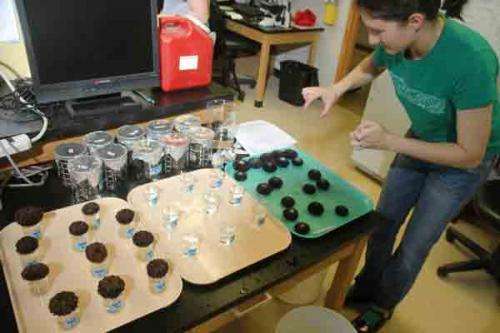April 9, 2013 report
Sea urchins cope with rising CO2 levels

(Phys.org) —Increasing levels of carbon dioxide (CO2) in the atmosphere are causing oceans to become more acidic. This situation poses a threat to marine organisms with shells made of calcium carbonate, because acid will corrode these shells. If they are to survive, these organisms will have to adapt to conditions of high acidity. In a paper published in Proceedings of the National Academy of Sciences, Melissa Pepseni of Indiana University at Bloomington and her colleagues at Stanford University and University of California, Davis report that when exposed to high CO2 levels, purple sea urchins (Strongylocentrotus purpuratus) experience significant changes in genes that affect survival in an acidic environment. This indicates that the sea urchins can adapt to high CO2 levels caused by climate change.
Pepseni and her team chose to study sea urchins, which have calcium carbonate spines, because these marine animals have very high levels of genetic variability. The scientists collected adult purple sea urchins from the North American Pacific coast, a region that often experiences upwellings of CO2-rich water; sea urchins from this region may already have a high proportion of alleles associated with survival in high CO2 conditions.
After fertilizing eggs from females with sperm from males, the scientists raised the larvae produced in conditions of either ambient or elevated acidity. Ambient levels corresponded to atmospheric CO2 levels of 400 parts per million. Elevated levels of 900 ppm matched expected atmospheric CO2 concentrations in the year 2100.
Larvae in both groups survived long enough to metamorphose to the next juvenile state. Although the larvae raised in the high acid condition experienced a slight reduction in size, possibly reflecting increased energy costs, this had no affect on their survival rate.
Other than that, there were few visible differences between the two groups. However, gene sequencing showed that the high CO2 group experienced significant changes in genes related to mineral growth, lipid metabolism and ion homeostasis, all of which affect the ability to cope with high acid levels. Genetic variation in the ambient CO2 group was random.
The researchers believe that natural selection in the high CO2 group encouraged the promotion of alleles increasing fitness in an acid environment. While the study reveals that marine organisms can sometimes adapt to high acid levels, they caution that the ability to adapt successfully in a challenging environment requires genetic diversity. Sea urchins are already extremely diverse genetically and those used in the study could already have inherited a higher proportion of alleles associated with survival in high CO2 conditions. Other organisms may not have these advantages. In addition, stressors such as temperature change and overfishing could reduce population sizes and therefore decrease genetic diversity even further.
More information: Evolutionary change during experimental ocean acidification, PNAS, Published online before print April 8, 2013, doi: 10.1073/pnas.1220673110
Abstract
Rising atmospheric carbon dioxide (CO2) conditions are driving unprecedented changes in seawater chemistry, resulting in reduced pH and carbonate ion concentrations in the Earth's oceans. This ocean acidification has negative but variable impacts on individual performance in many marine species. However, little is known about the adaptive capacity of species to respond to an acidified ocean, and, as a result, predictions regarding future ecosystem responses remain incomplete. Here we demonstrate that ocean acidification generates striking patterns of genome-wide selection in purple sea urchins (Strongylocentrotus purpuratus) cultured under different CO2 levels. We examined genetic change at 19,493 loci in larvae from seven adult populations cultured under realistic future CO2 levels. Although larval development and morphology showed little response to elevated CO2, we found substantial allelic change in 40 functional classes of proteins involving hundreds of loci. Pronounced genetic changes, including excess amino acid replacements, were detected in all populations and occurred in genes for biomineralization, lipid metabolism, and ion homeostasis—gene classes that build skeletons and interact in pH regulation. Such genetic change represents a neglected and important impact of ocean acidification that may influence populations that show few outward signs of response to acidification. Our results demonstrate the capacity for rapid evolution in the face of ocean acidification and show that standing genetic variation could be a reservoir of resilience to climate change in this coastal upwelling ecosystem. However, effective response to strong natural selection demands large population sizes and may be limited in species impacted by other environmental stressors.
Journal information: Proceedings of the National Academy of Sciences
© 2013 Phys.org
















